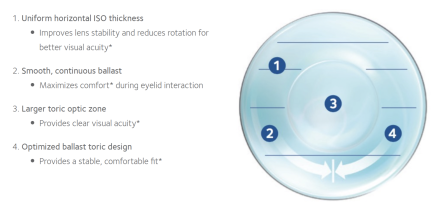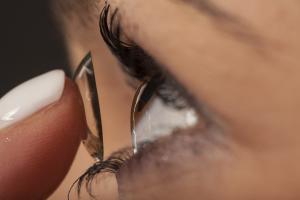by Courtney Dryer, OD

Estimates suggest that approximately 50% of patients have significant astigmatism (≥ 0.75D) and these patients are often fit with a spherical contact lens resulting in sub-par vision.1 Toric contact lenses can make a considerable difference in vision clarity, eye fatigue, and decrease the errors patients may be making in their work.
With advancements in technology, toric contact lenses can be just as comfortable as spherical lenses and are now available in daily lens modalities. While the proportion of toric lens fits has increased, there remains a significant number of patients who would benefit and are not currently wearing a lens for astigmatism.2 What is astigmatism?
What is Astigmatism?
The most asked question of an ECP.
Astigmatism is a refractive condition of the eye where parallel rays of light that enter the eye are brought to a focus at two distinct focal lines perpendicular to each other, rather than to a single focal point. It occurs due to meridional variations in the curvature or alignment of the eye's optical components along their primary meridians. Typically, these variations are due to the cornea or the lens inside the eye.3
It has been documented that 60% of the adult population ≥0.25 diopters of astigmatism but the amount may vary by age or ethnicity. The axis of the astigmatism may also change with age.3
The exact cause of astigmatism is still not known. Genetics may play a role in the development of astigmatism.4 Other factors such as eyelid pressure, extraocular muscle forces, and nutrition may also be involved in astigmatism development.3
What makes a toric lens different from a spherical contact lens?
A toric contact lens is designed differently than a spherical contact lens. The stabilization of the lens is dependent on the interaction between the lid and lens. A toric soft contact lens requires stability with the blink for consistent visual performance. Various methods are used to stabilize lens rotation including prism-ballast, peri-ballast and thin-zone designs.1

Each manufacturer has its own design, but an optimized prism-ballast design used in the Biofinity Toric performed best. The Biofinity Toric® design was compared to PureVision® Toric (B&L), Air Optix® for Astigmatism (Alcon), Biofinity® Toric (CooperVision), Acuvue® Advance for Astigmatism (Vistakon), and Proclear® Toric (CooperVision).1 According to a study conduct by Moghaddam et al, the Biofinity toric® showed the lowest rotation from the vertical position and reoriented after the blink the fastest.1 These two factors are key to consistent, clear vision.
How does a toric lens correct for astigmatism?
Toric lenses have different refractive powers on the vertical and horizontal orientations to match the meridional variations of the eye. The axis of the lens must match the axis of the astigmatism of the eye as much as possible to achieve optimal vision.1
Does a patient with astigmatism really need a specialty contact lens?
If a patient has -0.75 or more of astigmatism, they will see better with a toric contact lens. Even relatively low amounts of astigmatism can lead to reductions in visual performance. The impact of astigmatic blur upon vision depends upon the axis of the astigmatism. WTR astigmatism (axis 180) reduces distance vision the least when compared to other types of astigmatism.3
Contrast sensitivity and stereoacuity (binocular vision) are also affected by induced astigmatism.3 Multiple studies demonstrate using toric lenses to correct astigmatism improve driving safety particularly at night.5
Near vision is reduced by uncorrected astigmatism by a similar amount as distance vision. Astigmatism can affect an individual’s ability to both read and perform computer work. In young adults, even relatively small levels (1.00 D) of induced astigmatism reduce reading performance, particularly for those with ATR astigmatism and small print sizes.6
Researchers also report a significant reduction in the performance of a computer-based editing task in those individuals with 1.50D of uncorrected astigmatism. Participants took longer to complete the task and had an increase in the number of errors.7 Studies indicate that uncorrected astigmatism may impact several common occupational visual tasks, particularly those with a high visual demand.
Research also indicates there may be a link between astigmatism and visual discomfort. Study participants with 0.50 D of ATR (axis 90) astigmatism report an increase in discomfort following a 25 min computer reading task. Additionally, reports indicate that a 10 min computer reading task performed with 2.00 D induced oblique astigmatic blur resulted in a significant increase in reported eye and vision related symptoms (‘tired eyes’, ‘discomfort in eyes’, and ‘blurred vision’) compared to performing the task with the prescribed refractive correction.8
How can I best educate patients on the differences?
Even if fit with the same brand they are currently wearing, patients often report toric contact lenses feel differently. Some describe lens edge awareness while others note differences in their peripheral vision.
Easing patients’ apprehension by explaining the differences and reassuring them their experience is normal can aid in their adaptation and lens acceptance. I always describe the change as buying a new pair of shoes, you may feel the arch or the shoe tongue until wear becomes routine.
I prefer to educate my toric lens wears on how their lenses are different. I find they are more likely to be successful if they understand that their contact lenses may take a little longer to settle but wearing a toric contact lens is necessary to provide them with the clarity they need.
Switching an existing sphere lens wearer to a toric, may take a little additional hand holding, but pointing out the difference in clarity can increase your patient’s confidence.
Studies show that those fit in toric contacts are mostly likely to discontinue their lenses due to poor vision so proper follow-up in new lens wearers is key to prevent contact lens dropout.9
When fitting a toric contact lens, patient education is key. Focus on the benefits of a toric lens including improvements in clarity, contrast, driving, and performance on computer and reading tasks.
_______________________
Resources:
Momeni-Moghaddam H, Naroo SA, Askarizadeh F, et al. Comparison of fitting stability of the different soft toric contact lenses. Cont Lens Anterior Eye. 2014 Oct;37(5):346-50. doi: 10.1016/j.clae.2014.05.003. Epub 2014 Jun 2. PMID: 24894546.
Morgan PB, Efron N. Prescribing soft contact lenses for astigmatism. Cont Lens Anterior Eye. 2009 Apr;32(2):97-8. doi: 10.1016/j.clae.2008.10.006. Epub 2009 Jan 30. PMID: 19185528.
Read SA, Vincent SJ, Collins MJ. The visual and functional impacts of astigmatism and its clinical management. Ophthalmic Physiol Opt. 2014 May;34(3):267-94. doi: 10.1111/opo.12128. Epub 2014 Mar 18. PMID: 24635572.
Read SA, Collins MJ, Carney LG. A review of astigmatism and its possible genesis. Clin Exp Optom. 2007 Jan;90(1):5-19. doi: 10.1111/j.1444-0938.2007.00112.x. PMID: 17177660.
Cox DJ, Banton T, Record S, Grabman JH, Hawkins RJ. Does correcting astigmatism with toric lenses improve driving performance? Optom Vis Sci. 2015 Apr;92(4):404-11. doi: 10.1097/OPX.0000000000000554. PMID: 25946099.
Wills J, Gillett R, Eastwell E et al. Effect of simulated astigmatic refractive error on reading performance in the young. Optom Vis Sci 2012; 89: 271–276.
Sheedy JE & Bailey IL. Task performance and contrast polarity on hard copy and video displays. Proc. SPIE 1249, Human Vision and Electronic Imaging: Models, Methods and Applications 1990; 45–53.
Rosenfield M, Hue JE, Huang RR & Bababekova Y. The effects of induced oblique astigmatism on symptoms and reading performance while viewing a computer screen. Ophthalmic Physiol Opt 2012; 32: 142–148.
Pucker AD, Tichenor AA. A review of contact lens dropout. Clin Optom (Auckl). 2020;12:85-94. Published 2020 Jun 25. doi:10.2147/OPTO.S198637








